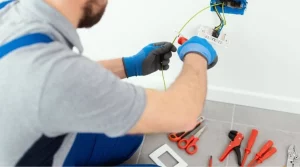The installation of Ground Fault Circuit Interrupter (GFCI) outlets is crucial for enhancing home safety, particularly in areas susceptible to moisture. Understanding the associated costs is important for homeowners. Basic outlet prices vary, but installation expenses can escalate considerably. Various factors, including regional labor rates and installation complexities, play a role in determining the final price. For those planning upgrades, it’s helpful to research the cost of installing GFCI outlets to budget accurately and ensure compliance with safety standards. Evaluating these elements is essential for making informed decisions about home safety and electrical compliance.
Key Takeaways
- GFCI outlets, costing $15 – $30 each, are crucial for safety in moisture-prone areas, reducing electrical shock risks.
- Professional installation typically ranges from $100 – $200 per outlet, influenced by regional labor rates and complexity.
- Additional costs may arise from wiring upgrades or permits, potentially adding $50 – $150 to the overall installation price.
- DIY installation can save on labor but requires electrical knowledge and may lead to future compliance issues if done incorrectly.
- Long-term benefits include enhanced safety, potentially lower insurance premiums, and increased property value from improved safety features.
The Importance of GFCI Outlets in Home Safety
GFCI outlets play an essential role in enhancing home safety by considerably reducing the risk of electrical shock in areas prone to moisture, such as kitchens and bathrooms. These devices detect imbalances in electrical current, immediately cutting off power to prevent potential hazards. Their importance is underscored by electrical safety codes, which mandate their installation in specific locations, reflecting a growing recognition of consumer safety. Additionally, GFCI outlets contribute to overall household well-being by fostering a secure environment for families, particularly those with children or elderly members. By integrating these outlets into residential electrical systems, homeowners not only comply with regulations but also demonstrate a commitment to safeguarding their loved ones, ultimately enhancing the sense of belonging within their living spaces.
Factors Influencing the Cost of Installing GFCI Outlets
Several factors contribute to the overall cost of installing GFCI outlets, impacting both materials and labor. The type and quality of the GFCI outlet itself greatly influence material costs; higher-rated models tend to be more expensive. Additionally, the complexity of the installation site plays a vital role. For example, installations in existing walls may require more labor and time compared to new constructions. Labor rates vary by region and contractor experience, further affecting total expenses. Electrical codes and regulations also dictate specific requirements, which can lead to additional costs if upgrades or modifications are necessary. Finally, the presence of other electrical components or potential hazards can complicate the installation process, thereby increasing the cost of installing GFCI outlets.
Average Costs and Price Ranges for GFCI Outlet Installation
When considering the cost of installing GFCI outlets, understanding the average expenses associated with this upgrade is vital. Typically, the price of installing GFCI outlets can vary greatly based on several factors, including labor rates and materials used. The average price range for this installation generally falls between:
- Basic GFCI Outlet: $15 – $30 per unit.
- Professional Installation: $100 – $200 per outlet, inclusive of labor.
- Additional Wiring or Electrical Work: $50 – $150, depending on existing infrastructure.
- Permit Fees: $10 – $50, if required by local codes.
Ultimately, the overall price of installing GFCI outlets can fluctuate based on specific project requirements, making it essential for homeowners to obtain detailed estimates before proceeding.
DIY vs. Professional Installation: Cost Considerations
Determining whether to pursue a DIY approach or hire a professional for GFCI outlet installation involves careful consideration of various cost factors. The DIY route may initially appear cost-effective, as it eliminates labor expenses; however, it requires an understanding of electrical systems and adherence to safety regulations. The cost of installing GFCI outlets includes materials and potential tools, which can accumulate. Conversely, hiring a licensed electrician incurs higher upfront costs, but guarantees compliance with local codes and professional expertise, potentially preventing future issues. Homeowners should weigh the initial savings of DIY against the long-term value and safety assurance offered by professional installation, ultimately deciding which approach aligns with their financial and safety priorities in the price of installing GFCI outlets.
Long-term Benefits of Investing in GFCI Outlets
Investing in GFCI outlets offers significant long-term benefits that extend beyond immediate safety concerns. These advantages contribute to enhanced home safety, reduced liability, and overall cost-effectiveness, particularly when evaluating the cost of installing GFCI outlets.
- Increased Safety: Minimizes the risk of electrical shock in wet areas.
- Insurance Benefits: May lower homeowner insurance premiums by reducing risk.
- Property Value: Enhances home resale value due to improved safety features.
- Peace of Mind: Guarantees a safer living environment for families and guests.
Frequently Asked Questions
What Types of GFCI Outlets Are Available on the Market?
Various GFCI outlets are available, including duplex, weather-resistant, and tamper-resistant models. Each type addresses specific safety needs and environments, allowing consumers to select suitable options based on installation location and intended usage.
How Long Does It Take to Install a GFCI Outlet?
The installation of a GFCI outlet typically requires 1 to 2 hours, depending on the complexity of the existing wiring and the installer’s experience. Proper assessment guarantees efficient and safe installation, aligning with electrical standards.
Can I Install a GFCI Outlet Outdoors?
Yes, a GFCI outlet can be installed outdoors, provided it is weather-resistant and properly housed. Such installations enhance safety by protecting against electrical shock in wet conditions, ensuring compliance with local electrical codes and standards.
What Is the Lifespan of a GFCI Outlet?
The lifespan of a GFCI outlet typically ranges from 10 to 30 years, depending on usage and environmental factors. Regular testing and maintenance are essential to guarantee peak performance and safety throughout its operational life.
Are There Any Rebates for Installing GFCI Outlets?
The availability of rebates for installing GFCI outlets varies by region and utility provider. Homeowners should consult local energy efficiency programs or governmental initiatives to determine possible financial incentives for GFCI outlet installation.
Conclusion
To conclude, the installation of GFCI outlets is a critical investment for enhancing home safety, particularly in moisture-prone areas. While basic outlet costs are relatively low, the total expense can increase considerably when factoring in professional installation and regional variations. Homeowners must weigh the benefits of hiring a licensed electrician against the appeal of DIY options. Ultimately, the long-term advantages of GFCI outlets, including improved safety and property value, justify the investment.
You May Also Like To Read:






